Throne of Darkness Updated Preview
We take an extensive look at the upcoming RPG from Click Entertainment.
We were recently invited to Click Entertainment's San Francisco studios to play an advanced build of its upcoming action RPG, Throne of Darkness. Set in a rather dark interpretation of feudal Japan, the game puts you in the role of a party of samurai, who must rid their homeland of evil. A despotic king-turned-dark-warlord, as the story goes, has marshaled a vast army of undead warriors and is rapidly overtaking the countryside. As the honor guard of the land's sole surviving daimyo, it's your job to vanquish the evil force and restore order.
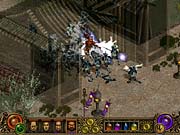
Throne of Darkness is an action RPG in the spirit of Diablo. As such, all movement and combat is accomplished by means of a mouse click--simply click on your destination or target, and your will is enacted. Because the two people in charge of Click Entertainment are ex-Blizzard developers, however, this should come as no surprise. The team wholeheartedly embraces the play mechanics established by Blizzard's classic and has managed to build upon them a tight and playable, if familiar, system. Throne of Darkness' most obvious deviation from the Diablo formula is that it lets you control an entire party of four samurai at one time. While you can directly control only one character at any given moment, toggling between active characters is as simple as hitting the space bar to cycle through your ranks quickly and effectively. Because it's possible to quickly switch between active characters, you'll find that doing so will become an integral part of your strategy--the game's battlefields are fairly large, and the "center" of fights will change often, so you'll usually want to switch to the character nearest to the center.
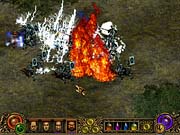
Your party is composed of seven members, each one specialized in a certain area of combat: There's the brick, who's large and hardy but relatively slow and dim-witted; the mage, who's not as burly as his kin but is the game's most powerful spellcaster; and the leader, who has the highest charisma score, which makes it easy for him to call tactics. There's also a well-rounded swordsman, a mighty berserker, a deft archer, and a deadly ninja.
Calling tactics plays a huge role in the game's battles. Tactics are basically a preset suite of party configurations, which manipulate your samurai's position in battle. There are 12 tactics, and they're all named after animals, which is reflected in the formations they cause your party to take--the snake formation, for example, will cause your party to position itself in a zigzag line, with hardier members hopefully taking the front, while spellcasters and missile users bring up the rear. If a particular tactic's configuration isn't working for you, you can change it--characters' positions are all changeable by means of the tactics editor, so you can tweak (and save) your ideal configuration. Characters' individual combat roles can be altered with the editor as well. You can set everything from their aggressiveness ratings to their primary and secondary weapons and spells. In the end, you have a good amount of control over all members of your party, even when they're fighting via AI. And control is a definite necessity when it comes to Throne of Darkness' thick, nasty battles.
Playing the Game
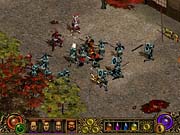
Click Entertainment let us play a large part of the game's first stage during our recent visit. It began in the castle of your party's daimyo, which was under attack by the dark warlord's army. We started out in control of three characters--the other four were scattered throughout the keep, presumably staving off the infernal onslaught. Needless to say, each room brought with it relatively large battles, and the enemies took many forms--undead footmen, pikemen, and archers were not uncommon. These were the reanimated corpses of dead soldiers, and they looked a lot like regular grunts, save for their pale, rotting flesh. The battles unfolded just as you'd expect them to--mad amounts of frenetic mouse-clicking, frequently interrupted by a greedy scanning of the environment for dropped goods.
We started on the top floor of the castle and eventually made our way down through the structure's levels. Each level brought battles thicker than the previous, and each added a rescued samurai to our ranks. Fresh samurai were whisked away, upon rescue, to the daimyo's sanctuary, which serves as your bench, of sorts. You can access the daimyo at any time--it occupies a central position in the game's interface--and swap out characters, as well as resurrect your fallen. Each of these actions costs the daimyo mana, which replenishes over time.
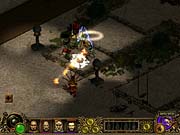
The game's Diablo-style pacing seldom relented, and the battles only got bigger. Occasionally we'd stumble onto an impassable barrier that only the brick character could crush through, but aside from this, the game followed the tried-and-true formula of engaging enemies and scouring for treasure. Barrels, chests, and other treasure receptacles were in no short supply, but neither were traps--exploding barrels and trapped treasure boxes being two examples.
Eventually the battle took us to the castle's courtyard and outlying areas. This is where the game's first boss-type character made an appearance--a dark, twisted sorcerer with the ability to cast destructive spells. Though he was pretty powerful on his own, he was accompanied by all manner of undead soldiers, including a particularly harsh type of giant hammer-wielding skeleton. The combined might of our ninja, archer, brick, and mage dispatched them all in due order, however, but not without some clever tactics-calling and vital potion-chugging. Shortly after, we rescued our blacksmith and priest--both nonplayer characters but essential members of the party nonetheless. The blacksmith serves as both the game's weapon shop and imbuing station. You can access him at any time and commission him to perform a number of useful actions for your party, including repairing and creating equipment and imbuing it with magical powers. To create a weapon or a piece of armor, you first have to "sacrifice" the type of item that you wish to create. After you've provided the necessary components, the blacksmith will set himself to the task of building your weapon. Creating equipment takes time, however, and your wait is directly correlative to the value of the piece being created--anywhere from a few seconds to several minutes. The same goes for imbuing items--you provide the slotted weapon and the items (usually a gem or the body part of a special monster) whose power you wish to imbue into the weapon and depending on the strength of the resultant item, you might wait a while.
Final Thoughts
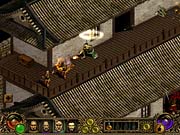
The priest serves as both your channel to the game's gods and as a healer and potion shop. The way to gain spells in Throne of Darkness is to sacrifice items to the game's gods. Each god has a magic type associated with it--the thunder god will grant you lightning spells, while the fire god will grant you fire magic. As you pay them tribute, their favor toward you rises, and eventually, if you're particularly pious, you'll gain a spell point with which to advance on the spell tree. The progression is very similar to Diablo II's--higher-level spells become accessible as you master lower-level magic, which provides a steady, balanced progression. Court the favor of two gods simultaneously, however, and you'll gain access to special combo magic that combines the effects of two different elements. While we didn't have a chance to sample any of the higher-level spells (our mage was relatively low-level, after all), Click assures us that their effects will be both spectacular and destructive. The priest's other function, at any rate, was that of an ever-accessible potion shop. Through his menu, you can buy both health- and mana-restoring potions, as well as dual-purpose elixirs and antidotes for poison.
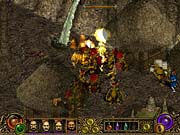
Unfortunately, our demo of the game ended shortly after rescuing the priest. The last phase of it involved fighting huge armored turtle-like creatures called kappa, whose attacks were both heavy-handed and poisonous. We fought them near a lake in an open field shortly after engaging a group of the undead. Prior to encountering the frogs that would be our demise, however, we were able to combat the enemy in what appeared to be a ruined village. Scores of undead soldiers occupied the small settlement, and its inhabitants were nowhere to be seen. In the center of the town, however, was a most grisly sight--a large stone mill overflowing with human corpses, spewing a small stream of blood. The device, apparently, was used to generate undead soldiers, and manning it were two corpulent demons. The demons were rather tough, but we eventually got the best of them and were rewarded with their blubber--a useful component for creating magical weapons. Other types of enemies in that area included mounted undead warriors and forest oni--or forest demons--which resemble tall plump hairy clawed trolls.
We really wanted to sample the game's multiplayer component--which consists of a unique interpretation of a king-of-the-hill game--but unfortunately the build we played didn't have the feature implemented. The final game will pit four teams against the dark warlord, with the victor taking his place--and gaining access to the special dark-magic tree--after which the game starts over. The game as a whole was looking rather good, aside from a few kinks, and Click should have it suitably polished for its upcoming release. Fans of Diablo-style action RPGs will have their work cut out for them, as both Throne's release and the upcoming Diablo II expansion are slated for the relatively near future. We'll bring you an update as soon as one becomes available.
Got a news tip or want to contact us directly? Email news@gamespot.com
Join the conversation